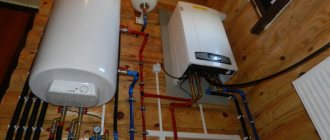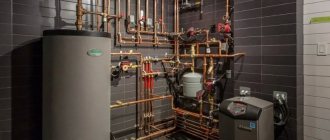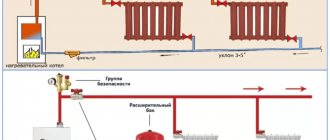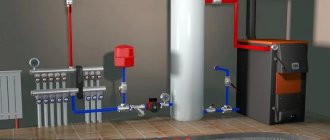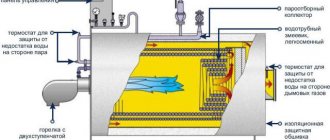Heating systems using gas as fuel are highly efficient and reliable. The thermal energy generators in them have impressive efficiency and are safe to use. There are several ways to organize gas heating for a private home.
There are solutions both budget-friendly and more expensive with maximum efficiency and operational stability. We are ready to share with you proven options for installing a gas heating system. Using our recommendations guarantees the construction of a trouble-free and secure network.
The information we provide is based on building regulations. The information offered for review is supplemented by visual photo illustrations, diagrams and video tutorials.
Where to begin
Before you start figuring out how to make gas heating yourself, you need to leave behind naive thoughts about what will happen without gas service employees. Unfortunately, it is impossible to do all the work yourself.
In any case, you will have to involve specialists. But to reduce costs, you can install a lot of things with your own labor.
Why do we rely on gas:
- This is a cheap source of raw materials for combustion and heat transfer to the house. Even firewood is approximately twice as expensive to heat an identical living space;
- The operation of gas implies the absence of soot or combustion products, which is an undoubted advantage in comparison with firewood, coal, and pallets;
- Modern gas systems come with a thermostat - this allows you to regulate the temperature level;
- The equipment does not heat up much as a result of gas combustion. This practically eliminates the possibility of fire in a wooden wall, rafter or beam.
But most of the economic benefits relate to the centralized method of gas supply. Unfortunately, based on cylinders, the cost is expected to increase by 6 - 7 times.
Financial costs are almost comparable to the costs of operating an electric boiler. Therefore, we will not take this option into account.
Characteristics of liquefied gas
The properties of liquefied gas are not much inferior to natural material. It is widely used in everyday life, for example, for heating a house. Of course, such systems are less convenient to use than main gas wiring. But, if we compare liquefied gas with other alternative solutions for a country house, then there are definitely more advantages. In particular, such material burns well. Moreover, this process can be fully automated thanks to the availability of a huge range of modern equipment. In other words, boilers operating on its basis can operate without stopping. However, it is not necessary to monitor the operation of such equipment.
Schemes for individual heating of a house. based on the use of liquefied gas are also good because they are silent in operation. This cannot be said about analogues that use liquid fuel. The gas heating scheme for a private house may include converters as a base. In this case, a separate envelope is installed in each room.
This equipment is especially effective in cases where it is necessary to heat two adjacent rooms.
Optimal gas heating scheme
You can rely on 2 diagrams related to the types of available heating devices. They are based on one operating principle: gas heats water to distribute and release heat throughout the entire area of the house. The choice is made based on the characteristics of residential meters.
Available heating schemes:
- Single-circuit gas boiler. It is characterized by a constant volume of coolant in the heating system.
- Double-circuit gas boiler. It has the additional ability to heat water for household use. To do this, a plate flow model of the heater or a storage version of the tank is used with the addition of its own burner and the ability to regulate power thanks to a thermostat. Therefore, such an implementation becomes not only part of the heating system. It increases the comfort of life in the home by providing warm water for washing dishes and taking a bath.
Selecting the wiring type
Gas heating allows any type of wiring. They choose a scheme based on the area of the house, number of storeys, convenience and possibilities, including financial ones.
The wiring, along with the area, determines the power of the boiler and the need for one or another electrical equipment.
Wiring type
There are 3 options: single-pipe, double-pipe and beam.
- The single-pipe scheme is the simplest. One pipe is sequentially supplied to each radiator along its “path” and returns to the boiler. Here the coolant heats up and the cycle repeats. Suitable for small buildings and technical structures.
- Two-pipe - one pipe goes from battery to battery and carries hot water. The second pipe removes the cooled coolant from the radiators in the opposite direction. This scheme ensures more uniform heating of the entire circuit and can serve a larger area. The use of taps makes adjustments easier. The system is used for heating residential buildings and cottages.
- Radial - here the heated coolant first enters the collector, and from here hot water is supplied to each radiator through an individual pipe. This scheme allows not only to uniformly heat a very large area, but also to heat individual rooms in a random order, heating them to different temperatures. Installation is very expensive, as it requires laying a large number of pipes and very precise settings.
A one- and two-pipe system can be natural, a radial system can only be forced.
Water circulation
In simple systems, it is possible to ensure that water flows by gravity from one battery to another. In this case, the pipes are laid at a certain angle, and an expansion tank is placed at the top point of the system. The latter compensates for the difference in pressure. The scheme requires precise calculations. Not suitable for “warm floors”.
Forced – the movement of the coolant is provided by an electric pump. This is more expensive, but it solves all the problems with a large number of pipes and a complex pipeline configuration.
Vertical and horizontal
This type of wiring is related to the location of the supply pipes.
Horizontal – supply and discharge pipes are located horizontally. In one-story buildings, this option is used, since it is very simple and allows you to do without a pump.
Vertical - heating radiators are divided into some kind of sections, for example, along one wall. A vertical pipe is connected to the section and hot water is supplied through it. It is also discharged through a vertical drain. This scheme is carried out in multi-apartment and multi-storey buildings.
Vertical wiring can only be forced. Here you definitely need a circulation pump to pump water.
What to do before installing the boiler
You will have to take into account that without a gas service, it is prohibited by law to connect a gas boiler and operate a heating or water heating system.
Necessary steps before installation:
- All documents and constituent papers are collected to approve the planned project. This is needed for the gas service. She will sign the permit only after a complete review of the project.
- Additionally, you will need an explanation of who will do the installation. The performer must have permission. For their part, gas workers will help supply gas to the required place in the house.
- Gas equipment, consumables and a full list of components are purchased. You can save a little, but you can’t do without the basic elements of the system.
- A connection is made into a centralized gas pipeline to connect to a fuel source.
- You can install a boiler and connect to a pipe system with radiators.
Therefore, it will not be possible to do without the help of the gas service. But you can do some of the work yourself.
Materials and tools
To build a gas boiler, prepare the following materials and tools:
- electric drill;
- pliers;
- level;
- corner;
- roulette;
- metal pipe;
- steel sheet;
- gas pipe;
- doors for creating a firebox;
- red brick;
- fittings;
- clay;
- galvanized sheet;
- welding tool;
- thermostat;
- automation;
- deflector.
If everything is clear with most of the above, then choosing the right automation, deflector and thermostat is not the easiest task. What to look for when choosing them:
Thermostats can be wired or wireless. The former are slightly cheaper than the latter. Choose programmable models; they make it easier to control and regulate the boiler temperature. Structurally, the thermostat consists of two devices. One is placed in the room, the other on the facade of the boiler. When the room temperature drops, the thermostat starts the heater
Pay attention to domestic device models. They are in no way inferior to expensive foreign analogues; The concept of “automation for gas boilers” includes: flame control module, overheating protection, draft controller, blast valve
These devices are sold separately. For normal operation of the heater, all of the listed devices are needed. Do not choose the cheapest or too expensive models. Stop at the average price; The deflector provides good exhaust. It is installed on top of the chimney pipe. For a homemade gas boiler, a model in the form of a cone-shaped stainless steel umbrella is suitable.
What is required to connect the boiler?
Unfortunately, this is not a simple matter, and for this, as we understand, you need permission from the gas service. The problem lies in the danger of gas. If you make a small mistake, then an explosion is possible or the reptile may enter the living space, which may cause dire consequences.
First, you should rinse the pipes in the boiler. Let's move on to inspecting the reliability of the wall for mounting the boiler. A gasket based on a material inert to combustion is mounted to it. Maintain a distance of 5 cm from the boiler to the gasket.
The quality of the ventilation system and the cleanliness of the chimney are checked. If the permit is in hand, then there is nothing stopping you from moving on to the next stage.
Set of tools for boiler installation:
- Self-tapping screws with a large diameter of 6 mm, 4 units required;
- Marker for marking;
- Pobedite drill;
- Working drill;
- Plastic dowels;
- Reliable level;
- Parapet.
Materials for work:
- Three-core wire;
- Elbow for forming a chimney;
- Parallel bracket;
- Corner filter with mesh structure;
- Ball valves;
- Paronite gasket;
- Detector for gas appearance outside the boiler;
- Certificate for installation and operation of gas equipment.
A true owner relies on his own strengths and strives to do everything for comfort in the house. But, if there is no permission, then it is prohibited and dangerous to carry out the entire installation of the gas system. You can limit yourself to the delivery and preparatory stage of the site for installing the boiler, laying pipes, and leave the rest to the gas service specialists.
Connecting the boiler yourself (instructions)
As we understand, this requires permission from the gas workers. But where to start doing the work? It is important to secure the boiler correctly. Large screws are used for this.
Let's look at the stages:
- We use pre-prepared: 4 self-tapping screws with a diameter of 6 mm. Thanks to the marker, the corresponding holes are marked on the wall. They are drilled with a pobedit drill.
- Dowels are inserted into the holes.
- The boiler is being installed.
- The elbow for the chimney system is put on.
- The structure is fixed to the wall thanks to self-tapping screws.
- In the lower part, the distance to the floor is 80 cm, and to the wall 50 cm. It is important to place the boiler evenly.
- We check with a level or plumb line.
- You can attach a parapet bracket.
- The boiler is connected to the pipes. Before connecting, you need to get rid of the factory plugs. We use a mesh filter for protection. It is necessary to get rid of debris before water enters the heat exchanger. Ball valves are mounted on both sides of the filters.
- Here is an important point: only gas service experts can connect to the gas pipe. For this, only a rigid connection is used, thanks to a metal pipe. To ensure safety, a paronite gasket must be added.
- It is equally important to install a gas meter, a gas outlet alarm, and a thermal shut-off valve. Without this, you cannot use a gas boiler.
It is important to use a three-wire wire to connect to the electrical network.
Now you can turn on the water. It is important to maintain a pressure of 1 bar. Then you can tighten the valve. A test run is being carried out.
Now we realize the benefits of gas heating for the home. But, if you plan to install gas heating in an apartment as an autonomous system, so as not to depend on the level of centralized heat, timing of switching on or off, or accidents on the line.
Then you will have to face practically the same stages. They should not be considered separately.
Classification of gas boilers, main operational characteristics, recommendations for selection
Domestic gas boilers used for heating systems of private houses and apartments are divided according to the following criteria:
- Installation method;
- Power;
- Type of gas burner;
- Burner ignition method;
- Type of traction;
- Combustion chamber type;
- Number of circuits;
- Heat exchanger material.
Let us consider the characteristics of these parameters in more detail.
Installation method (location)
- Parapet . They have a small power of 5-15 kW and are used for heating apartments and small houses. Installed on the wall, or under windows. The chimney (coaxial) is discharged through a hole in the wall directly at the installation site;
- Wall mounted . The power range of wall-mounted gas boilers is 10-35(40) kW. They have small overall dimensions, some models have a stylish design that allows them to be installed in the kitchen without covering them with a false panel. Compact, the design includes all the necessary devices and control systems. They have wide functionality. Their use is quite acceptable for one- and two-story houses of small and medium size, subject to high-quality insulation;
- Floor-standing . They are characterized by high power, performance and wide functionality. A chimney pipe is required; in some cases, installation must be carried out in a special room.
Number of circuits
- Single-circuit devices, the sole purpose of which is to heat the heating fluid of the heating system;
- Double-circuit - in addition to heating, they heat water for the DHW system. There are flow-through or with a built-in boiler. The latter are more economical to operate, but have somewhat larger overall dimensions and cost. In summer, double-circuit boilers can operate exclusively in DHW mode.
Type of traction
Each type of boiler, (except electric), regardless of the type of fuel, needs oxygen for combustion. The method of its arrival is called draft.
Natural cravings . It implies the supply of air directly from the room in which the boiler is installed. Water vapor and combustion products are removed through a vertical chimney. The design of such boilers is somewhat simpler, and the cost is correspondingly lower. In addition, they have additional advantages: quiet operation, energy independence. However, such devices are sensitive to gas pressure. At low pressure, the burner flame may go inward, causing it to burn out.
Forced draft . The design of such a boiler includes fans that supply air to the closed combustion chamber. The exhaust of combustion products and the intake of air from outside the building is carried out through the same coaxial chimney. This design has its advantages:
- Air from the room is not used, so there is no need to create a ventilation system;
- There is no need to build an expensive vertical chimney;
- Stability of operation is ensured even with a significant decrease in pressure in the gas pipeline;
- The boiler can be installed in any room, there is no need to build a boiler room;
The disadvantages of a forced draft boiler are:
- Noisy operation – the sound from the fan is quite loud;
- High price;
- Energy dependence.


